4.7: Potential and Field Relationships (Exercises)
( \newcommand{\kernel}{\mathrm{null}\,}\)
Conceptual Questions
Electric Field from Electric Potential
17. If the electric field is zero throughout a region, must the electric potential also be zero in that region?
18. Explain why knowledge of →E(x,y,z) is not sufficient to determine V(x,y,z). What about the other way around?
Equipotential Curves and Surfaces
19. If two points are at the same potential, are there any electric field lines connecting them?
20. Suppose you have a map of equipotential surfaces spaced 1.0 V apart. What do the distances between the surfaces in a particular region tell you about the strength of the →E in that region?
Conductors in Electrostatic Equilibrium
21. Is the electric potential necessarily constant over the surface of a conductor?
22. Under electrostatic conditions, the excess charge on a conductor resides on its surface. Does this mean that all of the conduction electrons in a conductor are on the surface?
23. Can a positively charged conductor be at a negative potential? Explain.
24. Can equipotential surfaces intersect?
Applications of Electric Potential and Conductors in Electrostatic Equilibrium
25. Why are the metal support rods for satellite network dishes generally grounded?
Problems
Electric Field from Electric Potential
55. Throughout a region, equipotential surfaces are given by z=constant. The surfaces are equally spaced with V=100V for z=0.00m,V=200V for z=0.50m,V=300V for z=1.00m. What is the electric field in this region?
56. In a particular region, the electric potential is given by V=−xy2z+4xy. What is the electric field in this region?
57. Calculate the electric field of an infinite line charge, throughout space.
Equipotential Curves and Surfaces
Conductors in Electrostatic Equilibrium
58. Two very large metal plates are placed 2.0 cm apart, with a potential difference of 12 V between them. Consider one plate to be at 12 V, and the other at 0 V. (a) Sketch the equipotential surfaces for 0, 4, 8, and 12 V.
(b) Next sketch in some electric field lines, and confirm that they are perpendicular to the equipotential lines.
59. A very large sheet of insulating material has had an excess of electrons placed on it to a surface charge density of \displaystyle –3.00nC/m^2.
(a) As the distance from the sheet increases, does the potential increase or decrease? Can you explain why without any calculations? Does the location of your reference point matter?
(b) What is the shape of the equipotential surfaces?
(c) What is the spacing between surfaces that differ by 1.00 V?
60. A metallic sphere of radius 2.0 cm is charged with \displaystyle +5.0-μC charge, which spreads on the surface of the sphere uniformly. The metallic sphere stands on an insulated stand and is surrounded by a larger metallic spherical shell, of inner radius 5.0 cm and outer radius 6.0 cm. Now, a charge of \displaystyle −5.0-μC is placed on the inside of the spherical shell, which spreads out uniformly on the inside surface of the shell. If potential is zero at infinity, what is the potential of
(a) the spherical shell,
(b) the sphere,
(c) the space between the two,
(d) inside the sphere, and
(e) outside the shell?
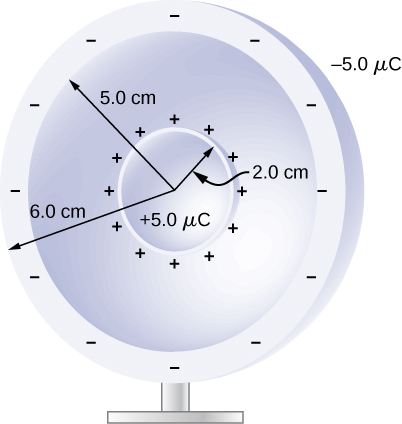
61. Two large charged plates of charge density \displaystyle ±30μC/m^2 face each other at a separation of 5.0 mm.
(a) Find the electric potential everywhere.
(b) An electron is released from rest at the negative plate; with what speed will it strike the positive plate?
62. A long cylinder of aluminum of radius R meters is charged so that it has a uniform charge per unit length on its surface of \displaystyle λ.
(a) Find the electric field inside and outside the cylinder.
(b) Find the electric potential inside and outside the cylinder. (c) Plot electric field and electric potential as a function of distance from the center of the rod.
63. Two parallel plates 10 cm on a side are given equal and opposite charges of magnitude \displaystyle 5.0×10^{−9}C.The plates are 1.5 mm apart. What is the potential difference between the plates?
64. The surface charge density on a long straight metallic pipe is \displaystyle σ. What is the electric potential outside and inside the pipe? Assume the pipe has a diameter of 2a.

65. Concentric conducting spherical shells carry charges Q and –Q, respectively. The inner shell has negligible thickness. What is the potential difference between the shells?
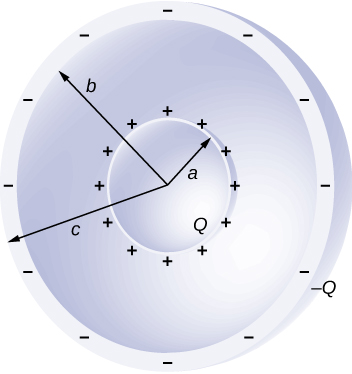
66. Shown below are two concentric spherical shells of negligible thicknesses and radii \displaystyle R_1 and \displaystyle R_2. The inner and outer shell carry net charges \displaystyle q_1 and \displaystyle q_2, respectively, where both \displaystyle q_1 and \displaystyle q_2 are positive. What is the electric potential in the regions (a) \displaystyle r<R_1, (b) \displaystyle R_1<r<R_2, and (c) \displaystyle r>R_2?
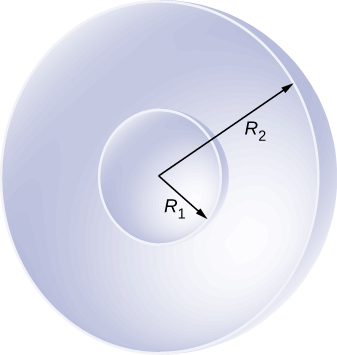
67. A solid cylindrical conductor of radius a is surrounded by a concentric cylindrical shell of inner radius b. The solid cylinder and the shell carry charges Q and –Q, respectively. Assuming that the length L of both conductors is much greater than a or b, what is the potential difference between the two conductors?
Applications of Electric Potential and Conductors in Electrostatic Equilibrium
68. (a) What is the electric field 5.00 m from the center of the terminal of a Van de Graaff with a 3.00-mC charge, noting that the field is equivalent to that of a point charge at the center of the terminal?
(b) At this distance, what force does the field exert on a \displaystyle 2.00-μC charge on the Van de Graaff’s belt?
69. (a) What is the direction and magnitude of an electric field that supports the weight of a free electron near the surface of Earth?
(b) Discuss what the small value for this field implies regarding the relative strength of the gravitational and electrostatic forces.
70. A simple and common technique for accelerating electrons is shown in Figure \PageIndex{1}, where there is a uniform electric field between two plates. Electrons are released, usually from a hot filament, near the negative plate, and there is a small hole in the positive plate that allows the electrons to continue moving.
(a) Calculate the acceleration of the electron if the field strength is \displaystyle 2.50×10^4N/C.
(b) Explain why the electron will not be pulled back to the positive plate once it moves through the hole.
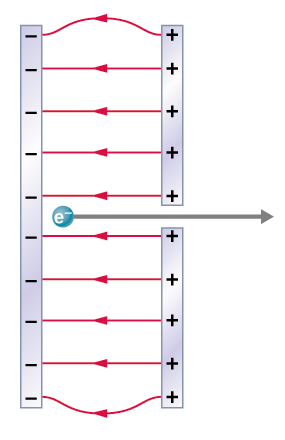
71. In a Geiger counter, a thin metallic wire at the center of a metallic tube is kept at a high voltage with respect to the metal tube. Ionizing radiation entering the tube knocks electrons off gas molecules or sides of the tube that then accelerate towards the center wire, knocking off even more electrons. This process eventually leads to an avalanche that is detectable as a current. A particular Geiger counter has a tube of radius R and the inner wire of radius a is at a potential of \displaystyle V_0 volts with respect to the outer metal tube. Consider a point P at a distance s from the center wire and far away from the ends.
(a) Find a formula for the electric field at a point P inside using the infinite wire approximation.
(b) Find a formula for the electric potential at a point P inside.
(c) Use \displaystyle V_0=900V, a=3.00mm, R=2.00cm, and find the value of the electric field at a point 1.00 cm from the center.
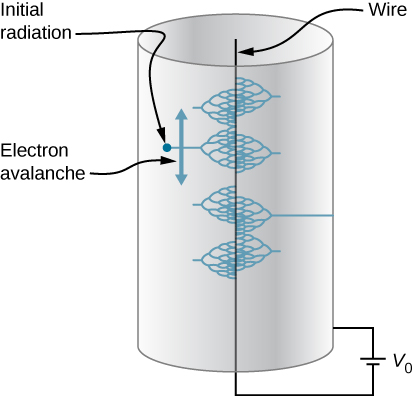
72. The practical limit to an electric field in air is about \displaystyle 3.00×10^6N/C. Above this strength, sparking takes place because air begins to ionize.
(a) At this electric field strength, how far would a proton travel before hitting the speed of light (ignore relativistic effects)?
(b) Is it practical to leave air in particle accelerators?
73. To form a helium atom, an alpha particle that contains two protons and two neutrons is fixed at one location, and two electrons are brought in from far away, one at a time. The first electron is placed at \displaystyle 0.600×10^{−10}m from the alpha particle and held there while the second electron is brought to \displaystyle 0.600×10^{−10}m from the alpha particle on the other side from the first electron. See the final configuration below.
(a) How much work is done in each step?
(b) What is the electrostatic energy of the alpha particle and two electrons in the final configuration?

74. Find the electrostatic energy of eight equal charges \displaystyle (+3µC) each fixed at the corners of a cube of side 2 cm.
75. The probability of fusion occurring is greatly enhanced when appropriate nuclei are brought close together, but mutual Coulomb repulsion must be overcome. This can be done using the kinetic energy of high-temperature gas ions or by accelerating the nuclei toward one another.
(a) Calculate the potential energy of two singly charged nuclei separated by \displaystyle 1.00×10^{−12}m.
(b) At what temperature will atoms of a gas have an average kinetic energy equal to this needed electrical potential energy?
76. A bare helium nucleus has two positive charges and a mass of \displaystyle 6.64×10^{–27}kg.
(a) Calculate its kinetic energy in joules at \displaystyle 2.00% of the speed of light.
(b) What is this in electron-volts?
(c) What voltage would be needed to obtain this energy?
77. An electron enters a region between two large parallel plates made of aluminum separated by a distance of 2.0 cm and kept at a potential difference of 200 V. The electron enters through a small hole in the negative plate and moves toward the positive plate. At the time the electron is near the negative plate, its speed is \displaystyle 4.0×10^5m/s. Assume the electric field between the plates to be uniform, and find the speed of electron at
(a) 0.10 cm,
(b) 0.50 cm,
(c) 1.0 cm, and
(d) 1.5 cm from the negative plate, and
(e) immediately before it hits the positive plate.

78. How far apart are two conducting plates that have an electric field strength of \displaystyle 4.50×10^3V/m between them, if their potential difference is 15.0 kV?
79. (a) Will the electric field strength between two parallel conducting plates exceed the breakdown strength of dry air, which is \displaystyle 3.00×10^6V/m, if the plates are separated by 2.00 mm and a potential difference of \displaystyle 5.0×10^3V is applied?
(b) How close together can the plates be with this applied voltage?
80. Membrane walls of living cells have surprisingly large electric fields across them due to separation of ions. What is the voltage across an 8.00-nm-thick membrane if the electric field strength across it is 5.50 MV/m? You may assume a uniform electric field.
81. A double charged ion is accelerated to an energy of 32.0 keV by the electric field between two parallel conducting plates separated by 2.00 cm. What is the electric field strength between the plates?
82. The temperature near the center of the Sun is thought to be 15 million degrees Celsius (\displaystyle 1.5×10^7°C) (or kelvin). Through what voltage must a singly charged ion be accelerated to have the same energy as the average kinetic energy of ions at this temperature?
83. A lightning bolt strikes a tree, moving 20.0 C of charge through a potential difference of 1\displaystyle .00×1^02 MV.
(a) What energy was dissipated?
(b) What mass of water could be raised from 15°C to the boiling point and then boiled by this energy?
(c) Discuss the damage that could be caused to the tree by the expansion of the boiling steam.
84. What is the potential \displaystyle 0.530×10^{−10}m from a proton (the average distance between the proton and electron in a hydrogen atom)?
85. (a) A sphere has a surface uniformly charged with 1.00 C. At what distance from its center is the potential 5.00 MV? (b) What does your answer imply about the practical aspect of isolating such a large charge?
86. What are the sign and magnitude of a point charge that produces a potential of –2.00 V at a distance of 1.00 mm?
87. In one of the classic nuclear physics experiments at the beginning of the twentieth century, an alpha particle was accelerated toward a gold nucleus, and its path was substantially deflected by the Coulomb interaction. If the energy of the doubly charged alpha nucleus was 5.00 MeV, how close to the gold nucleus (79 protons) could it come before being deflected?
Additional Problems
88. A 12.0-V battery-operated bottle warmer heats 50.0 g of glass, \displaystyle 2.50×10^2g of baby formula, and \displaystyle 2.00×10^2g of aluminum from 20.0°C to 90.0°C.
(a) How much charge is moved by the battery?
(b) How many electrons per second flow if it takes 5.00 min to warm the formula? (Hint: Assume that the specific heat of baby formula is about the same as the specific heat of water.)
89. A battery-operated car uses a 12.0-V system. Find the charge the batteries must be able to move in order to accelerate the 750 kg car from rest to 25.0 m/s, make it climb a \displaystyle 2.00×10^2-m high hill, and finally cause it to travel at a constant 25.0 m/s while climbing with \displaystyle 5.00×10^2-N force for an hour.
90. (a) Find the voltage near a 10.0 cm diameter metal sphere that has 8.00 C of excess positive charge on it.
(b) What is unreasonable about this result?
(c) Which assumptions are responsible?
91. A uniformly charged half-ring of radius 10 cm is placed on a nonconducting table. It is found that 3.0 cm above the center of the half-ring the potential is –3.0 V with respect to zero potential at infinity. How much charge is in the half-ring?
92. A glass ring of radius 5.0 cm is painted with a charged paint such that the charge density around the ring varies continuously given by the following function of the polar angle \displaystyle θ,λ=(3.0×10^{−6}C/m)cos^2θ.. Find the potential at a point 15 cm above the center.
93. A CD disk of radius (\displaystyle R=3.0cm) is sprayed with a charged paint so that the charge varies continually with radial distance rfrom the center in the following manner: \displaystyle σ=−(6.0C/m)r/R. Find the potential at a point 4 cm above the center.
94. (a) What is the final speed of an electron accelerated from rest through a voltage of 25.0 MV by a negatively charged Van de Graff terminal? (b) What is unreasonable about this result? (c) Which assumptions are responsible?
95. A large metal plate is charged uniformly to a density of \displaystyle σ=2.0×10^{−9}C/m^2. How far apart are the equipotential surfaces that represent a potential difference of 25 V?
96. Your friend gets really excited by the idea of making a lightning rod or maybe just a sparking toy by connecting two spheres as shown in Figure 7.39, and making \displaystyle R_2 so small that the electric field is greater than the dielectric strength of air, just from the usual 150 V/m electric field near the surface of the Earth. If \displaystyle R_1 is 10 cm, how small does \displaystyle R_2 need to be, and does this seem practical? (Hint: recall the calculation for electric field at the surface of a conductor from Gauss’s Law.)
97. (a) Find \displaystyle x>>L limit of the potential of a finite uniformly charged rod and show that it coincides with that of a point charge formula. (b) Why would you expect this result?
98. A small spherical pith ball of radius 0.50 cm is painted with a silver paint and then \displaystyle −10μC of charge is placed on it. The charged pith ball is put at the center of a gold spherical shell of inner radius 2.0 cm and outer radius 2.2 cm.
(a) Find the electric potential of the gold shell with respect to zero potential at infinity.
(b) How much charge should you put on the gold shell if you want to make its potential 100 V?
99. Two parallel conducting plates, each of cross-sectional area \displaystyle 400cm^2, are 2.0 cm apart and uncharged. If \displaystyle 1.0×10^{12} electrons are transferred from one plate to the other,
(a) what is the potential difference between the plates?
(b) What is the potential difference between the positive plate and a point 1.25 cm from it that is between the plates?
100. A point charge of \displaystyle q=5.0×10^{−8}C is placed at the center of an uncharged spherical conducting shell of inner radius 6.0 cm and outer radius 9.0 cm. Find the electric potential at
(a) \displaystyle r=4.0cm,
(b) \displaystyle r=8.0cm,
(c) \displaystyle r=12.0cm.
101. Earth has a net charge that produces an electric field of approximately 150 N/C downward at its surface.
(a) What is the magnitude and sign of the excess charge, noting the electric field of a conducting sphere is equivalent to a point charge at its center?
(b) What acceleration will the field produce on a free electron near Earth’s surface?
(c) What mass object with a single extra electron will have its weight supported by this field?
102. Point charges of \displaystyle 25.0μC and \displaystyle 45.0μC are placed 0.500 m apart.
(a) At what point along the line between them is the electric field zero?
(b) What is the electric field halfway between them?
103. What can you say about two charges \displaystyle q_1 and \displaystyle q_2, if the electric field one-fourth of the way from \displaystyle q_1 to \displaystyle q_2 is zero?
104. Calculate the angular velocity \displaystyle ω of an electron orbiting a proton in the hydrogen atom, given the radius of the orbit is \displaystyle 0.530×10^{−10}m. You may assume that the proton is stationary and the centripetal force is supplied by Coulomb attraction.
105. An electron has an initial velocity of \displaystyle 5.00×10^6m/s in a uniform \displaystyle 2.00×10^5-N/C electric field. The field accelerates the electron in the direction opposite to its initial velocity.
(a) What is the direction of the electric field?
(b) How far does the electron travel before coming to rest?
(c) How long does it take the electron to come to rest?
(d) What is the electron’s velocity when it returns to its starting point?
Challenge Problems
106. Three \displaystyle Na^+ and three \displaystyle Cl^− ions are placed alternately and equally spaced around a circle of radius 50 nm. Find the electrostatic energy stored.
107. Look up (presumably online, or by dismantling an old device and making measurements) the magnitude of the potential deflection plates (and the space between them) in an ink jet printer. Then look up the speed with which the ink comes out the nozzle. Can you calculate the typical mass of an ink drop?
108. Use the electric field of a finite sphere with constant volume charge density to calculate the electric potential, throughout space. Then check your results by calculating the electric field from the potential.
109. Calculate the electric field of a dipole throughout space from the potential.
Contributors and Attributions
Samuel J. Ling (Truman State University), Jeff Sanny (Loyola Marymount University), and Bill Moebs with many contributing authors. This work is licensed by OpenStax University Physics under a Creative Commons Attribution License (by 4.0).


